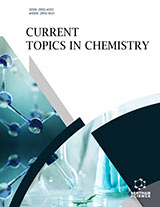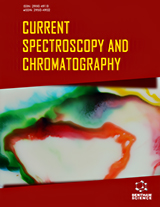Abstract
A series of new sensors (1, 2, 3 and 4) bearing aromatic hydroxyl group shows the strongest binding ability for AcO- by UV-vis, fluorescence, 1H NMR titrations and theoretical investigation. The sensitivity for AcO- can be tuned by electron push-pull properties of the substituents on the aromatic ortho position of the sensor. Especially, sensor 4 containing nitro group shows the best sensitivity. The excellent sensitivity of 4 for AcO- is attributed to the structure match of host-guest. In addition, the interacted process of host-guest accompanies color changes and can be used as new colorimetric chemosensors. Real life experimental result indicates that sensor 4 can be used to qualitatively detect the fluoride in toothpaste.
Keywords: Acetate detection, anion recognition, aromatic hydroxyl group, binding ability, chemosensor, colorimetric sensor, fluoride toothpaste, host-guest chemistry, molecular probe, selectivity, theoretical investigation
Current Analytical Chemistry
Title:Influence of Different Substituents on Anion Binding Ability in Aromatic Hydroxyl Group Derivatives: Experiment and Theory
Volume: 8 Issue: 3
Author(s): X. Shang, Y. Hao, Yi. Wang, J. Han, Y. Zhai, S. Jia, J. Zhang and X. Xu
Affiliation:
Keywords: Acetate detection, anion recognition, aromatic hydroxyl group, binding ability, chemosensor, colorimetric sensor, fluoride toothpaste, host-guest chemistry, molecular probe, selectivity, theoretical investigation
Abstract: A series of new sensors (1, 2, 3 and 4) bearing aromatic hydroxyl group shows the strongest binding ability for AcO- by UV-vis, fluorescence, 1H NMR titrations and theoretical investigation. The sensitivity for AcO- can be tuned by electron push-pull properties of the substituents on the aromatic ortho position of the sensor. Especially, sensor 4 containing nitro group shows the best sensitivity. The excellent sensitivity of 4 for AcO- is attributed to the structure match of host-guest. In addition, the interacted process of host-guest accompanies color changes and can be used as new colorimetric chemosensors. Real life experimental result indicates that sensor 4 can be used to qualitatively detect the fluoride in toothpaste.
Export Options
About this article
Cite this article as:
Shang X., Hao Y., Wang Yi., Han J., Zhai Y., Jia S., Zhang J. and Xu X., Influence of Different Substituents on Anion Binding Ability in Aromatic Hydroxyl Group Derivatives: Experiment and Theory, Current Analytical Chemistry 2012; 8 (3) . https://dx.doi.org/10.2174/157341112801264950
| DOI https://dx.doi.org/10.2174/157341112801264950 |
Print ISSN 1573-4110 |
| Publisher Name Bentham Science Publisher |
Online ISSN 1875-6727 |
 6
6
- Author Guidelines
- Bentham Author Support Services (BASS)
- Graphical Abstracts
- Fabricating and Stating False Information
- Research Misconduct
- Post Publication Discussions and Corrections
- Publishing Ethics and Rectitude
- Increase Visibility of Your Article
- Archiving Policies
- Peer Review Workflow
- Order Your Article Before Print
- Promote Your Article
- Manuscript Transfer Facility
- Editorial Policies
- Allegations from Whistleblowers
- Announcements
Related Articles
-
Delirium Secondary to Lamotrigine Toxicity
Current Drug Safety The Role of Microbiota and Intestinal Permeability in the Pathophysiology of Autoimmune and Neuroimmune Processes with an Emphasis on Inflammatory Bowel Disease Type 1 Diabetes and Chronic Fatigue Syndrome
Current Pharmaceutical Design Opioid Use Disorders in Adolescents: A Review of Prevalence, Problems, Clinical Features and Treatment Options
Adolescent Psychiatry Cinnamate Hybrids: A Unique Family of Compounds with Multiple Biological Activities
Current Pharmaceutical Biotechnology Microglia in Alzheimer's Disease: The Good, the Bad and the Ugly
Current Alzheimer Research Identifying the Structural Features of Pyrazolo[4,3-c]Quinoline-3-ones as Inhibitors of Phosphodiesterase 4: An Exploratory CoMFA and CoMSIA Study
Current Enzyme Inhibition Role of the Immune System in Autism Spectrum Disorders (ASD)
CNS & Neurological Disorders - Drug Targets Evidence-Based Review of Physiologic Effects of Kangaroo Care
Current Women`s Health Reviews Synthesis and Comparative Physical-chemical Characterisation of Neutral and Cationic Amphiphiles Using RP-HPLC
Current Analytical Chemistry Proceedings of the Regional Conference of the International Society for Adolescent Psychiatry and Psychology (ISAPP), a Joint Conference with 18<sup>th</sup> National Symposium of Adolescent Mental Health, Ankara, Turkey, November 21-24, 2013<sup>1</sup>
Adolescent Psychiatry Poly (D,L-Lactide-co-Glycolide) Nanoparticles Loaded with Cerebrolysin Display Neuroprotective Activity in a Rat Model of Concussive Head Injury
CNS & Neurological Disorders - Drug Targets Dopaminergic Enhancement of Cognitive Function
Current Pharmaceutical Design Macrophage Inflammatory Protein 1 and CCR5 as Attractive Therapeutic Targets for HIV Infection
Recent Patents on Anti-Infective Drug Discovery Freud Meets Bill W: A Model for the Dynamics of Alcoholics Anonymous
Adolescent Psychiatry Mitogen Activated Protein (MAP) Kinases: Development of ATP and Non- ATP Dependent Inhibitors
Medicinal Chemistry Current Evaluation of the Millennium Phytomedicine- Ginseng (II): Collected Chemical Entities, Modern Pharmacology, and Clinical Applications Emanated from Traditional Chinese Medicine
Current Medicinal Chemistry Chemistry and Biology of Indoles and Indazoles: A Mini-Review
Mini-Reviews in Medicinal Chemistry Meet Our Editorial Board Member
CNS & Neurological Disorders - Drug Targets An Overview of Non-Neural Sources of Calcitonin Gene-Related Peptide
Current Medicinal Chemistry Antidotes for Acute Cyanide Poisoning
Current Pharmaceutical Biotechnology


























